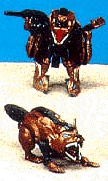 BEAST
WARS: TOY REVIEW
BEAST
WARS: TOY REVIEW
Name: SNARL
Allegiance: Maximal
Function: Lieutenant Commander
Beast Mode: Supposedly a Tasmanian
Devil
Average Price: 12 AUD
Note: Known in Japan as Tasmania Kid.

BEAST MODE
Length: 13.5cm
This toy looks NOTHING like a Tasmanian
Devil. The colours are all wrong. The moulding is
all wrong... it doesn't even have two thumbs like all marsupials do. It's
just some really weird animal... but it sure ain't a Tasmanian Devil. In
terms of colour, it's primarily brown with a grey stripe running down its
back with a thick, bushy grey tail. Since when have Tassie Devils ever
been brown? Everyone knows that they're black with a white stripe running
across, not along the chest and hindquarter.
Without exception, the head also looks nothing like that
of a Tasmanian Devil. It's got these two big-arse ears (WHY???)
and a really wide face (whereas Tas Devils actually have a more pointed
snout). It's actually a reasonably well constructed toy... and would be
half decent if not for the fact that it looks absolutely nothing like what
it's supposed to be!!!!!
It just looks more like a mutant rat-gremlin ... thing.
I'd better move on before I start swearing...
Gimmick: Press the button under the tail and the
rest of the body is supposed to launch forward. However, the spring is
piss-weak and it doesn't fly much farther than 10 centimetres.
TRANSFORMATION TO ROBOT MODE
Snarl was released as part of the 1997 assortment of basic
figures and is one of the first basics to break away from the spring loaded
one-flip transformation. Lift the sides up,
separate the head into two halves. Swing legs down, flip out robot heels
and flip up head halves to form robot feet. Swing the hind legs in and
the lower jaw down to form robot chest. The tail fits onto the forearms...
mounting on like G1 Megatron's fusion cannon... only that... it looks nothing
like a cannon or any other kind of ballistic weapon! At best, it's a really
weird baton.
ROBOT MODE
The most awkward looking part of this toy is the oversized
back section. The colour scheme is mainly brown and grey. I like the head
though. It's brown with a black face and blue eyes. Other than that, it's
not terribly impressive.
RUB STICKER LOCATION
None.
OVERALL
Just what the hell is that beast mode supposed to be??
BEAST TRIVIA
Tasmanian Devils (Sarcophilus harrisii) are large carnivorous marsupials.
Their large powerful jaws and teeth are noticeable, especially as the jaws
have a gape of 120 degrees. They are black in colour with a white
band on the chest and hindquarters and have hairless pink ears (nothing
like the toy!). The slightly smaller females have four teats in the backward-opening
pouch. Wild Tasmanian Devils often appear battle-scarred and have bald
patches on their coats.
Tasmanian Devils are found in all Tasmanian habitats, including rainforests,
eucalypt forests, farmlands and even outer city suburbs. Devils are not
territorial, but will wander over a range of 10-20 hectares in search of
food.
Tasmanian Devils are nocturnal, spending the daytime sleeping in dens
made in hollow logs, caves or old wombat burrows which they line with grass
and leaves.
Mating takes place between February and September and about 18 days
later, up to 30 joeys are born. Each is slightly larger than a grain of
rice and only between two and four are able to attach to milk teats in
the pouch and survive. They are carried in the pouch for about 15 weeks,
after which they are left in the nest while the mother is away feeding.
Later, they ride on the mother's back, or follow behind. They become independent
after about 28 weeks, and may live for up to 8 years.
Found only in Tasmania, Tasmanian Devils are quite common even in suburban
areas. They are often hit by cars as they feed on other road-killed animals.
They were once common on mainland Australia, with remains 600 years old
being found in Victoria. The arrival of the Dingo may have caused their
extinction on the mainland probably because they would have competed for
the same food.
By day, Devils are hidden away from danger in their burrows. If attacked,
adult Tasmanian Devils can use their threatening growls and powerful bite
to deter most animals. Young Devils are excellent tree climbers and it
is thought that this enables them to escape predators which may include
adult Devils.
Bibliography: Perth
Zoo.
Email
Back
 BEAST
WARS: TOY REVIEW
BEAST
WARS: TOY REVIEW